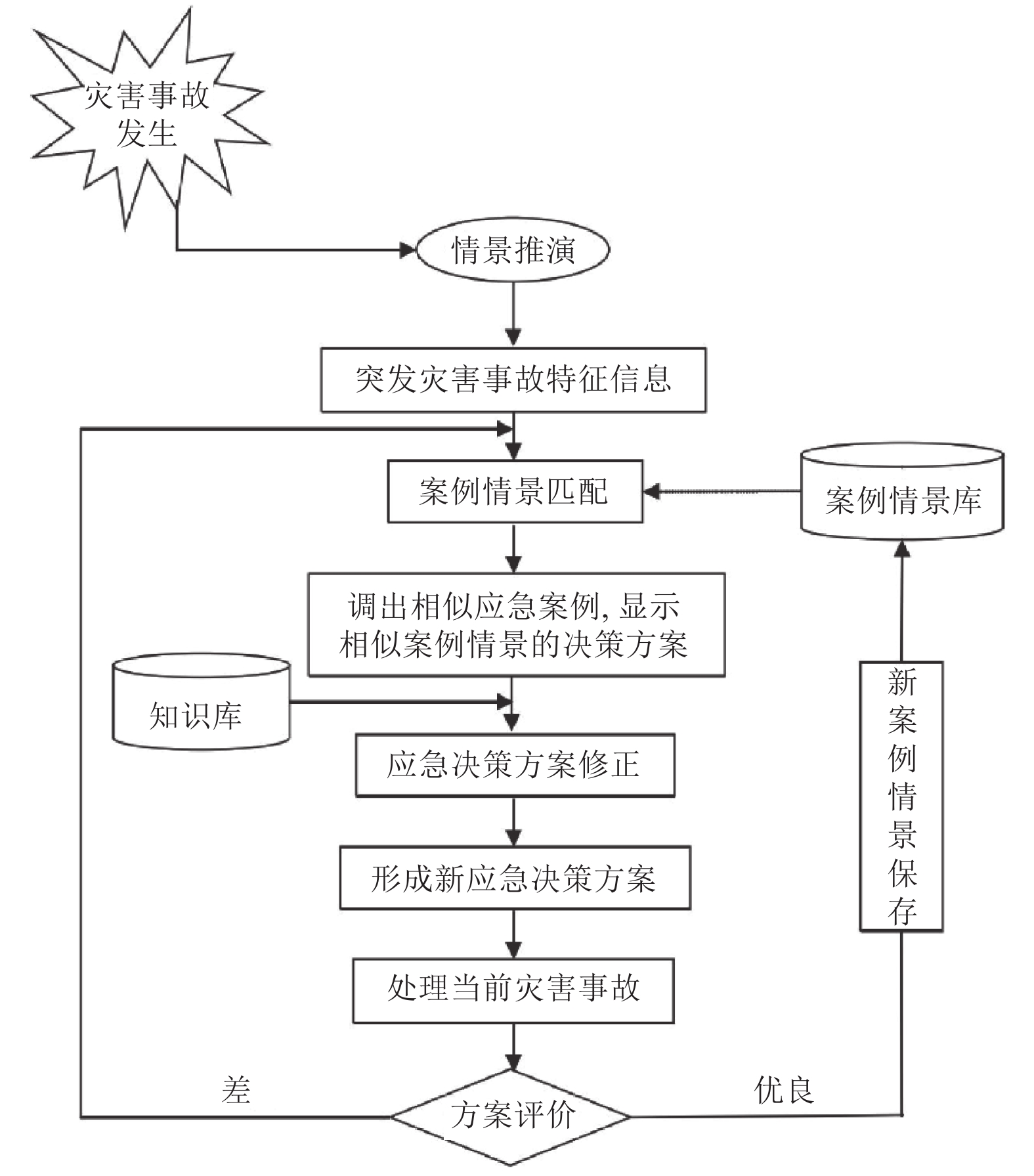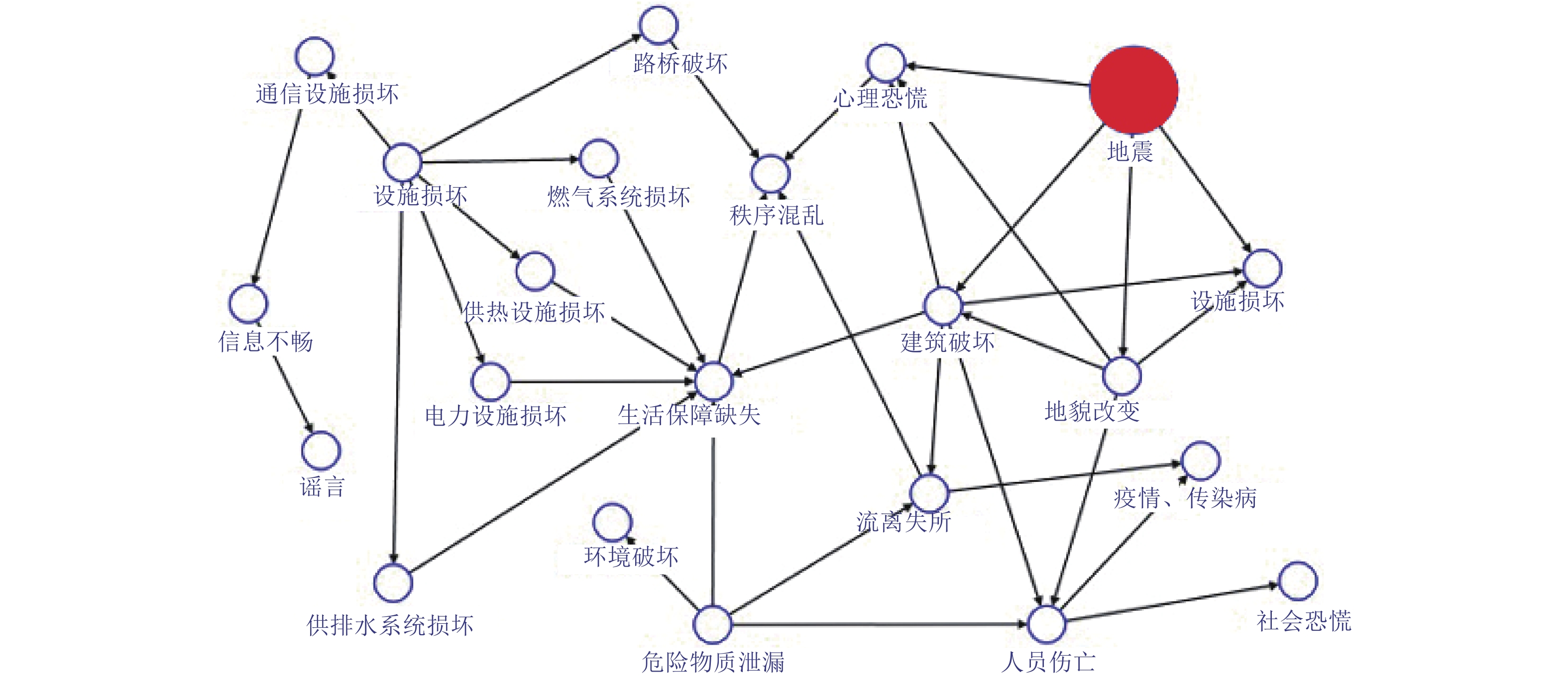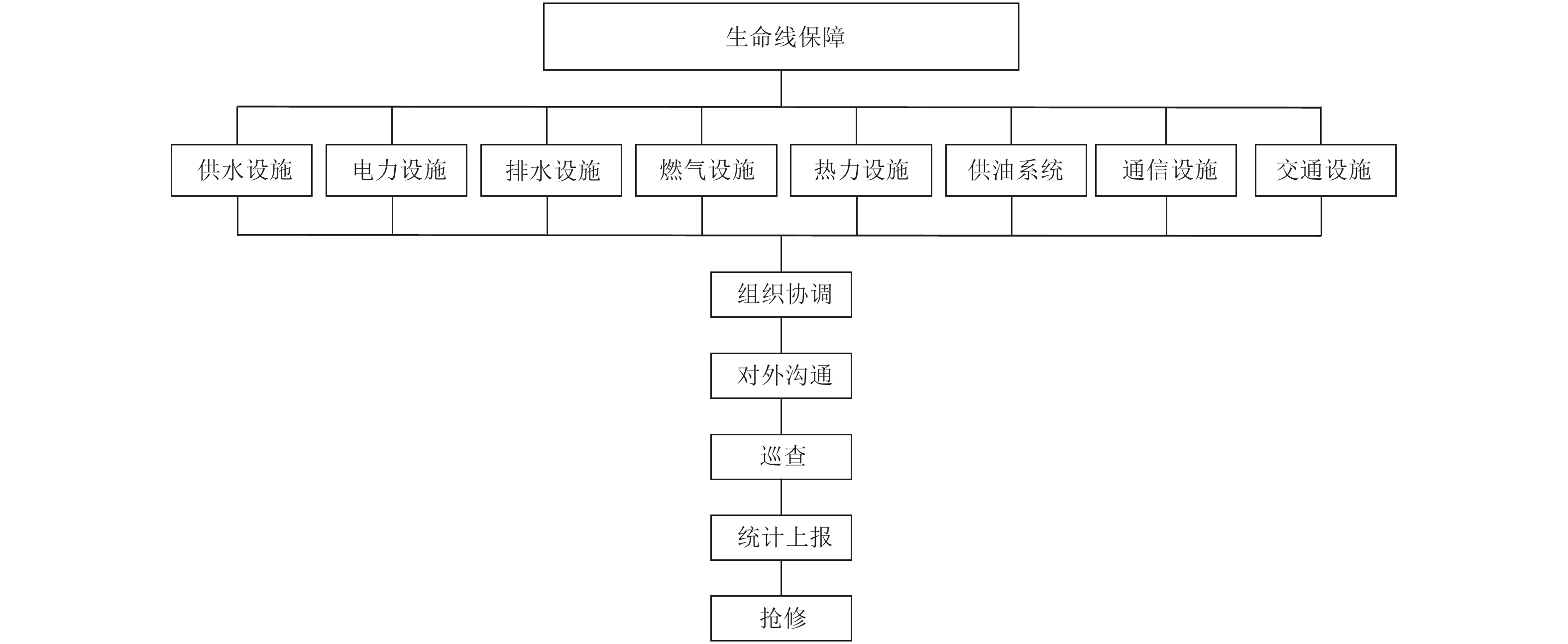The Development of “Scenario-response” Theoretical System and Its Application in Earthquake Disaster Emergency Management
-
摘要: “情景-应对”型理论体系基于事件静、动态情景分析生成应急决策方案,已成为重大突发事件应急决策的基本范式。近年来,“情景-应对”研究理论的迅速发展极大地拓宽了其应用范围,逐渐被引入地震应急中,在一定程度上能够弥补传统“预测-应对”模式的不足,为震后高效行动及充分应对提供有效支撑。本文从情景识别、情景推演及应对处置方案生成等方面详细介绍了“情景-应对”理论体系发展中涉及的关键技术,阐述了其在地震灾害应急管理中的应用。通过对已有研究的回顾,分析讨论了该领域的最新进展及需进一步解决的问题。Abstract: The “scenario-response” theoretical system, which generates emergency decision-making schemes based on the static and dynamic scenario analysis of unexpected incidents, has become the basic paradigm of emergency decision-making for major emergencies. In recent years, the rapid development of the “scenario-response” theory has greatly broadened its scope of application, and has been gradually applicable to earthquake emergency. To some extent, it could make up for the shortcomings of the traditional “prediction-response” model, and provide effective support for efficient and adequate post-earthquake actions. This paper introduces the key technologies involved in the development of the “scenario-response” from the aspects of scenario recognition, scenario deduction, and emergency decision-making schemes generation in detail, and then elaborates its application in earthquake disaster emergency management. Through the review of previous studies, the new progress in the field and the existing problems are analyzed and discussed.
-
表 1 部分情景条件概率取值
Table 1. Condition probabilities of some scenarios
情景名称 取值 发生概率 建筑物倒塌 极少倒塌 0.350 8 大半倒塌 0.223 4 绝大多数倒塌 0.425 7 通信中断 没有中断 0 中断 1 交通中断 没有中断 0 中断 1 供水、供电、供气设施破坏 设施破坏但短时间能恢复 0.331 8 瘫痪 0.668 2 危险品泄漏 没有泄漏 0.662 6 泄漏 0.337 4 火灾 极少(10次以下) 0.786 1 次数多/发生大规模火灾 0.213 9 人员死亡 在可接受死亡人数范围内 0.389 7 大于可接受死亡人数 0.610 3 生活物资缺乏程度 不缺乏 0.129 7 缺乏 0.870 3 社会大众恐慌程度 无 0 恐慌严重 1 社会公共安全事件严重程度 无 0.456 0 哄抢、抢劫等 0.544 0 疫情种类 无疫情或传染性小 0.576 5 死亡率高的传染性疾病 0.423 5 -
[1] 蔡友军, 林均岐, 刘金龙等, 2015. 基于贝叶斯模型的地震直接经济损失快速评估方法研究. 地震工程与工程振动, 35(2): 144—150Cai Y. J. , Lin J. Q. , Liu J. L. , et al. , 2015. Study on the rapid evaluation method for direct economic loss of earthquake based on Bayesian model. Earthquake Engineering and Engineering Dynamics, 35(2): 144—150. (in Chinese) [2] 曹海峰, 2018. 非常规突发事件应急预案研究. 北京: 社会科学文献出版社, 126—131Cao H. F. , 2018. Research on emergency plan of unconventional emergencies with scenario construction method. Beijing: Social Sciences Academic Press (China), 126—131. (in Chinese) [3] 陈波, 徐超, 温增平, 2015. 三维激光扫描技术在震害调查中的应用. 震灾防御技术, 10(1): 87—94 doi: 10.11899/zzfy20150109Chen B. , Xu C. , Wen Z. P. , 2015. The applications of 3D laser scanning technology in seismic damage survey. Technology for Earthquake Disaster Prevention, 10(1): 87—94. (in Chinese) doi: 10.11899/zzfy20150109 [4] 陈晨, 俞政, 张新梅, 2014. 考虑应急活动的非常规突发事件情景刻画研究. 中国安全科学学报, 24(10): 163—169Chen C. , Yu Z. , Zhang X. M. , 2014. Study on characterization of unconventional emergency scenarios considering emergency activities. China Safety Science Journal, 24(10): 163—169. (in Chinese) [5] 陈迎欣, 李烨, 魏薇, 2018. 云计算环境下基于任务-资源匹配的地震应急资源分配研究. 科技管理研究, 38(19): 202—208 doi: 10.3969/j.issn.1000-7695.2018.19.029Chen Y. X. , Li Y. , Wei W. , 2018. Research on allocation of earthquake emergency resource based on task-resources matching in cloud computing environment. Science and Technology Management Research, 38(19): 202—208. (in Chinese) doi: 10.3969/j.issn.1000-7695.2018.19.029 [6] 程希萌, 沈占锋, 邢廷炎等, 2016. 基于高分遥感影像的地震受灾建筑物提取与倒损情况快速评估. 自然灾害学报, 25(3): 22—31Cheng X. M. , Shen Z. F. , Xing T. Y. , et al. , 2016. Damaged building extraction and rapid assessment for earthquake disasters based on high-resolution remote sensing images. Journal of Natural Disasters, 25(3): 22—31. (in Chinese) [7] 冯海成, 冯翰, 2012. 国际救援队抗灾体适能的调查报告——及对初中生抗灾体适能培养的建议. 中国应急救援, (1): 14—16. [8] 巩前胜, 2018. “情景—应对”型应急决策中情景识别关键技术研究. 西安: 西安科技大学.Gong Q. S. , 2018. Research on the key techniques of scenario recognition in “Scenario-Response” emergency decision-making. Xi’an: Xi’an University of Science and Technology. (in Chinese) [9] 姜卉, 黄钧, 2009. 罕见重大突发事件应急实时决策中的情景演变. 华中科技大学学报(社会科学版), 23(1): 104—108Jiang H. , Huang J. , 2009. The study on the issues of scenario evolvement in real-time decision making of infrequent fatal emergencies. Journal of Huazhong University of Science and Technology (Social Science Edition), 23(1): 104—108. (in Chinese) [10] 姜卉, 2012. 应急实时决策中的情景表达及情景间关系研究. 电子科技大学学报(社科版), 14(1): 48—52Jiang H. , 2012. Expression of scenarios and the relationship among scenarios in emergency real-Time decision-Making. Journal of UESTC (Social Sciences Edition), 14(1): 48—52. (in Chinese) [11] 姜卉, 侯建盛, 2012. 基于情景推演与网络图技术的应急处置模式研究. 数学的实践与认识, 42(24): 21—32 doi: 10.3969/j.issn.1000-0984.2012.24.003Jiang H. , Hou J. S. , 2012. The study on the emergency disposition mode based on scenario derivation and network chart. Mathematics in Practice and Theory, 42(24): 21—32. (in Chinese) doi: 10.3969/j.issn.1000-0984.2012.24.003 [12] 李晋, 叶涵, 刘智等, 2017. 西南地区承灾体数据采集与动态更新系统. 震灾防御技术, 12(4): 858—869 doi: 10.11899/zzfy20170414Li J. , Ye H. , Liu Z. , et al. , 2017. Data collection and dynamic update system for hazard-affect buildings in southwestern China. Technology for Earthquake Disaster Prevention, 12(4): 858—869. (in Chinese) doi: 10.11899/zzfy20170414 [13] 李姜, 张合, 刘志辉等, 2021. 基于遥感影像的建筑抗震能力分析——以张家口万全区为例. 震灾防御技术, 16(2): 371—380 doi: 10.11899/zzfy20210216Li J. , Zhang H. , Liu Z. H. , et al. , 2021. Analysis of seismic capacity of buildings based on remote sensing image——taking Zhangjiakou Wanquan district as an example. Technology for Earthquake Disaster Prevention, 16(2): 371—380. (in Chinese) doi: 10.11899/zzfy20210216 [14] 李勇建, 乔晓娇, 孙晓晨等, 2015. 基于系统动力学的突发事件演化模型. 系统工程学报, 30(3): 306—318Li Y. J. , Qiao X. J. , Sun X. C. , et al. , 2015. Modeling the evolution of emergency based on system dynamics. Journal of Systems Engineering, 30(3): 306—318. (in Chinese) [15] 刘铁民, 2010. 危机型突发事件应对与挑战. 中国安全生产科学技术, 6(1): 8—12Liu T. M. , 2010. Crisis-type emergency response and challenges. Journal of Safety Science and Technology, 6(1): 8—12. (in Chinese) [16] 卢弋, 陈霖, 冯伟, 2021. 基于案例推理的城市轨道交通应急预警决策. 交通工程, 21(1): 74—79, 85Lu Y. , Chen L. , Feng W. , 2021. Research on decision-making of urban rail transit emergency warning based on case reasoning. Journal of Transportation Engineering, 21(1): 74—79, 85. (in Chinese) [17] 马亚杰, 李永义, 韩秀丽, 2007. 基于人工神经网络的地震经济损失评估. 世界地震工程, 23(1): 146—150 doi: 10.3969/j.issn.1007-6069.2007.01.028Ma Y. J. , Li Y. Y. , Han X. L. , 2007. Earthquake economic loss estimation based on the ANN. World Earthquake Engineering, 23(1): 146—150. (in Chinese) doi: 10.3969/j.issn.1007-6069.2007.01.028 [18] 马祖军, 谢自莉, 2012. 基于贝叶斯网络的城市地震次生灾害演化机理分析. 灾害学, 27(4): 1—5, 24 doi: 10.3969/j.issn.1000-811X.2012.04.001Ma Z. J. , Xie Z. L. , 2012. Evolution mechanism of earthquake-induced urban disasters based on bayesian networks. Journal of Catastrophology, 27(4): 1—5, 24. (in Chinese) doi: 10.3969/j.issn.1000-811X.2012.04.001 [19] 穆宣社, 2015. 基于地理空间大数据的应急指挥辅助决策平台研究. 测绘通报, (6): 93—96Mu X. S. , 2015. Research on emergency command decision support platform based on geospatial big data. Bulletin of Surveying and Mapping, (6): 93—96. (in Chinese) [20] 齐珉, 齐文华, 苏桂武, 2020. 基于新浪微博的2017年四川九寨沟7.0级地震舆情情感分析. 华北地震科学, 38(1): 57—63Qi M. , Qi W. H. , Su G. W. , 2020.2017 Sichuan Jiuzhaigou M7.0 earthquake sentiment analysis based on Sina Weibo. North China Earthquake Sciences, 38(1): 57—63. (in Chinese) [21] 郄子君, 2018. 基于关键承灾体的区域复杂灾害情景建模研究. 大连: 大连理工大学.Qie Z. J., 2018. Elements-at-risk as a framework for modeling the complex disaster scenario of hazard-affected regions. Dalian: Dalian University of Technology. (in Chinese) [22] 郄子君, 荣莉莉, 2020. 面向灾害情景推演的区域模型构建方法研究. 管理评论, 32(10): 276—292Qie Z. J. , Rong L. L. , 2020. A construction method of hazard-affected region for disaster scenario evolution. Management Review, 32(10): 276—292. (in Chinese) [23] 盛勇, 孙庆云, 王永明, 2015. 突发事件情景演化及关键要素提取方法. 中国安全生产科学技术, 11(1): 17—21Sheng Y. , Sun Q. Y. , Wang Y. M. , 2015. Emergency scenario evolution and extraction method of key elements. Journal of Safety Science and Technology, 11(1): 17—21. (in Chinese) [24] 苏桂武, Rodgers J. , 田青等, 2020. 参与式渭南地震情景构建: 中国地震风险对策的行动研究示范. 地震地质, 42(6): 1446—1473 doi: 10.3969/j.issn.0253-4967.2020.06.012Su G. W. , Rodgers J. , Tian Q. , et al. , 2020. The participatory construction of a seismic scenario for Weinan city: a pilot action research to address the improvement of earthquake disaster risk reduction in China. Seismology and Geology, 42(6): 1446—1473. (in Chinese) doi: 10.3969/j.issn.0253-4967.2020.06.012 [25] 汤文宇, 2007. CBR的应用研究. 南京: 南京邮电大学. [26] 王浩林, 范小晶, 2018. 基于情景匹配的海上船舶溢油事故危险性快速评估. 环境工程, 36(S1): 848—853Wang H. L. , Fan X. J. , 2018. Timely risk assessment of shipping oil spill based on situation matching. Environmental Engineering, 36(S1): 848—853. (in Chinese) [27] 王慧彦, 王建飞, 张敬军, 2016. 基于情景构建的地震巨灾准备计划框架. 自然灾害学报, 25(6): 112—119Wang H. Y. , Wang J. F. , Zhang J. J. , 2016. Framework of earthquake catastrophe preparedness planning based on scenarios. Journal of Natural Disasters, 25(6): 112—119. (in Chinese) [28] 王慧彦, 王建飞, 刘晓静, 2019. 基于情景的巨灾应对协同方法研究——以地震为例. 中国社会公共安全研究报告, (2): 79—97. [29] 王建飞, 2015. 基于情景平衡的地震灾害应急方案形成研究. 焦作: 河南理工大学.Wang J. F., 2015. Study on the earthquake emergency plan based on scenario balance. Jiaozuo: Henan Polytechnic University. (in Chinese) [30] 王建飞, 张景发, 2018. 基于情景平衡的地震应急方案生成模型. 安全与环境学报, 18(5): 1923—1930Wang J. F. , Zhang J. F. , 2018. Model for preparing an earthquake emergency plan based on the background scenario balance. Journal of Safety and Environment, 18(5): 1923—1930. (in Chinese) [31] 王循庆, 李勇建, 孙华丽, 2014. 基于随机Petri网的群体性突发事件情景演变模型. 管理评论, 26(8): 53—62, 116Wang X. Q. , Li Y. J. , Sun H. L. , 2014. Scenario evolvement model of unexpected incidents involving mass participation based on stochastic Petri nets. Management Review, 26(8): 53—62, 116. (in Chinese) [32] 王艳东, 李昊, 王腾等, 2016. 基于社交媒体的突发事件应急信息挖掘与分析. 武汉大学学报·信息科学版, 41(3): 290—297Wang Y. D. , Li H. , Wang T. , et al. , 2016. The mining and analysis of emergency information in sudden events based on social media. Geomatics and Information Science of Wuhan University, 41(3): 290—297. (in Chinese) [33] 武旭鹏, 夏登友, 李健行, 2014. 非常规突发事件情景描述方法研究. 中国安全科学学报, 24(4): 159—165Wu X. P. , Xia D. Y. , Li J. H. , 2014. Study on method for describing unconventional emergency scenario. China Safety Science Journal, 24(4): 159—165. (in Chinese) [34] 夏登友, 2015. 基于“情景—应对”的非常规突发灾害事故应急决策技术研究. 北京: 北京理工大学.Xia D. Y., 2015. Research on emergency decision-making for unconventional disasters and accidents based on scenario-response. Beijing: Beijing Institute of Technology. (in Chinese) [35] 许冲, 田颖颖, 沈玲玲等, 2018.2015年尼泊尔廓尔喀MW7.8地震滑坡数据库. 地震地质, 40(5): 1115—1128Xu C. , Tian Y. Y. , Shen L. L. , et al. , 2018. Database of landslides triggered by 2015 Gorkha (Nepal) MW7.8 earthquake. Seismology and Geology, 40(5): 1115—1128. (in Chinese) [36] 杨保华, 方志耕, 刘思峰等, 2012. 基于GERTS网络的非常规突发事件情景推演共力耦合模型. 系统工程理论与实践, 32(5): 963—970 doi: 10.3969/j.issn.1000-6788.2012.05.007Yang B. H. , Fang Z. G. , Liu S. F. , et al. , 2012. Model of co-coupling in unconventional incidents based on GERTS network. Systems Engineering-Theory & Practice, 32(5): 963—970. (in Chinese) doi: 10.3969/j.issn.1000-6788.2012.05.007 [37] 杨继君, 佘廉, 2016. 面向多灾点需求的应急资源调度博弈模型及优化. 中国管理科学, 24(8): 154—163Yang J. J. , She L. , 2016. Game model and optimization based on resource requirements of multiple crisis locations. Chinese Journal of Management Science, 24(8): 154—163. (in Chinese) [38] 杨青, 杨帆, 2012. 基于元胞自动机的突发传染病事件演化模型. 系统工程学报, 27(6): 727—738 doi: 10.3969/j.issn.1000-5781.2012.06.002Yang Q. , Yang F. , 2012. Emergency epidemics spread model using cellular automata. Journal of Systems Engineering, 27(6): 727—738. (in Chinese) doi: 10.3969/j.issn.1000-5781.2012.06.002 [39] 于山, 王海霞, 马亚杰, 2005. 三层BP神经网络地震灾害人员伤亡预测模型. 地震工程与工程振动, 25(6): 113—117 doi: 10.3969/j.issn.1000-1301.2005.06.019Yu S. , Wang H. X. , Ma Y. J. , 2005. Three-layer BP network model for estimation of casualties in an earthquake. Earthquake Engineering and Engineering Dynamics, 25(6): 113—117. (in Chinese) doi: 10.3969/j.issn.1000-1301.2005.06.019 [40] 袁晓芳, 田水承, 王莉, 2011. 基于PSR与贝叶斯网络的非常规突发事件情景分析. 中国安全科学学报, 21(1): 169—176 doi: 10.3969/j.issn.1003-3033.2011.01.028Yuan X. F. , Tian S. C. , Wang L. , 2011. Scenario analysis of unconventional emergency based on PSR model and Bayesian networks. China Safety Science Journal, 21(1): 169—176. (in Chinese) doi: 10.3969/j.issn.1003-3033.2011.01.028 [41] 张磊, 王延章, 陈雪龙, 2016. 基于知识元的非常规突发事件情景模糊推演方法. 系统工程学报, 31(6): 729—738Zhang L. , Wang Y. Z. , Chen X. L. , 2016. Fuzzy inference method for unconventional events scenarios based on knowledge unit. Journal of Systems Engineering, 31(6): 729—738. (in Chinese) [42] 张明红, 佘廉, 2016. 基于情景的突发事件演化模型研究——以青岛“11.22”事故为例. 情报杂志, 35(5): 65—71Zhang M. H. , She L. , 2016. A case study on the evolutionary model of emergency events based on scenario: the Qingdao "11.22" accident. Journal of Intelligence, 35(5): 65—71. (in Chinese) [43] 张明红, 2016. 基于案例的非常规突发事件情景推理方法研究. 武汉: 华中科技大学.Zhang M. H., 2016. Study on unconventional emergency scenario reasoning method the cases-based. Wuhan: Huazhong University of Science and Technology. (in Chinese) [44] 张文娟, 2019. 基于移动通信大数据的地震灾区人口伤亡获取与评估系统设计. 地震工程学报, 41(4): 1066—1071 doi: 10.3969/j.issn.1000-0844.2019.04.1066Zhang W. J. , 2019. Design of the population casualty acquisition and evaluation system in earthquake disaster areas based on mobile communication big data. China Earthquake Engineering Journal, 41(4): 1066—1071. (in Chinese) doi: 10.3969/j.issn.1000-0844.2019.04.1066 [45] 张莹, 郭红梅, 尹文刚等, 2019. 基于SIFT特征与SVM分类的地震灾情图像信息异常检测方法. 地震研究, 42(2): 265—272 doi: 10.3969/j.issn.1000-0666.2019.02.015Zhang Y. , Guo H. M. , Yin W. G. , et al. , 2019. Detection method of earthquake disaster image anomaly based on SIFT feature and SVM classification. Journal of Seismological Research, 42(2): 265—272. (in Chinese) doi: 10.3969/j.issn.1000-0666.2019.02.015 [46] 张英菊, 2016. 案例推理技术在环境群体性事件应急决策中的应用研究. 安全与环境工程, 23(1): 94—99.Zhang Y. J. , 2016. Research on application of CBR in emergency decision-making for environmental massive events. Safety and Environmental Engineering, 23(1): 94—99. (in Chinese) [47] 张媛, 王金萍, 赖俊彦等, 2020. 互联网+社区地震应急桌面演练的设计与实施——以青海省海西州为例. 震灾防御技术, 15(2): 411—418Zhang Y. , Wang J. P. , Lai J. Y. , et al. , 2020. Design and implementation of internet + community earthquake emergency tabletop exercises——a case study of Haixi prefecture in Qinghai province. Technology for Earthquake Disaster Prevention, 15(2): 411—418. (in Chinese) [48] 仲秋雁, 郭艳敏, 王宁等, 2012. 基于知识元的非常规突发事件情景模型研究. 情报科学, 30(1): 115—120Zhong Q. Y. , Guo Y. M. , Wang N. , et al. , 2012. Research on unconventional emergency scenario model based on knowledge element. Information Science, 30(1): 115—120. (in Chinese) [49] 朱达邈, 2017. 地震灾评推演训练中主要情景的客观度优化研究. 北京: 中国科学院大学.Zhu D. M., 2017. Research on objective optimization of main scenes in earthquake disaster assessment deduction training. Beijing: University of Chinese Academy of Sciences. (in Chinese) [50] Cosgrave J. , 1996. Decision making in emergencies. Disaster Prevention and Management, 5(4): 28—35. doi: 10.1108/09653569610127424 [51] Fahey L. , 1999. Competitor scenarios: projecting a rival’s marketplace strategy. Competitive Intelligence Review, 10(2): 65—85. doi: 10.1002/(SICI)1520-6386(199932)10:2<65::AID-CIR9>3.0.CO;2-Z [52] Gadomski A. M. , Bologna S. , Costanzo G. D. , et al. , 2001. Towards intelligent decision support systems for emergency managers: the IDA approach. International Journal of Risk Assessment and Management, 2(3—4): 224—242. [53] Gilbert A. L. , 2000. Using multiple scenario analysis to map the competitive futurescape: a practice-based perspective. Competitive Intelligence Review, 11(2): 12—19. doi: 10.1002/(SICI)1520-6386(200032)11:2<12::AID-CIR4>3.0.CO;2-E [54] Kahn H., Wiener A. J., 1967. The year 2000: a framework for speculation on the next thirty-three years. New York: MacMillan and Co Limited. [55] Kowalski-Trakofler K. M. , Vaught C. , Scharf T. , 2003. Judgment and decision making under stress: an overview for emergency managers. International Journal of Emergency Management, 1(3): 278—289. doi: 10.1504/IJEM.2003.003297 [56] Li X. L. , Li Z. Q. , Yang J. S. , et al. , 2020. Seismic vulnerability comparison between rural Weinan and other rural areas in Western China. International Journal of Disaster Risk Reduction, 48: 101576. doi: 10.1016/j.ijdrr.2020.101576 [57] Liu Y. H. , So E. , Li Z. Q. , et al. , 2020. Scenario-based seismic vulnerability and hazard analyses to help direct disaster risk reduction in rural Weinan, China. International Journal of Disaster Risk Reduction, 48: 101577. doi: 10.1016/j.ijdrr.2020.101577 [58] Rodgers J. , Su G. W. , Qi W. H. , et al. , 2020. Creating an earthquake scenario in China: a case study in Weinan City, Shaanxi Province. International Journal of Disaster Risk Reduction, 42: 101305. doi: 10.1016/j.ijdrr.2019.101305 [59] Wei Y. M. , Liang Q. M. , Fan Y. , 2006. A scenario analysis of energy requirements and Energy Intensity for China’s rapidly developing society in the year 2020. Technological Forecasting and Social Change, 73(4): 405—421. doi: 10.1016/j.techfore.2004.12.003 [60] Xu C., Dai F. C., Xu X. W., et al., 2012. GIS-based support vector machine modeling of earthquake-triggered landslide susceptibility in the Jianjiang River watershed, China. Geomorphology, 145—146: 70—80. -




 下载:
下载:




